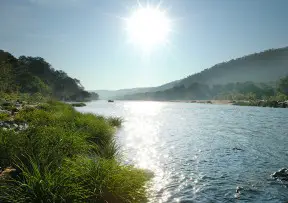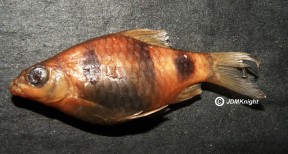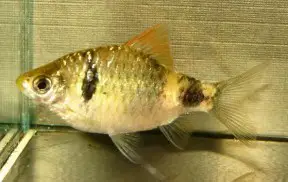Pethia setnai
Narayan Barb
SynonymsTop ↑
Puntius setnai Chhapgar & Sane, 1992
Etymology
Pethia: the generic vernacular name for small cyprinids in the Sinhala language.
setnai: named for Indian ichthyologist S. B. Setna.
Classification
Order: Cypriniformes Family: Cyprinidae
Distribution
Type locality is ‘Sanguem, Goa, western coast of India’, but current knowledge suggests that this species is common throughout most rivers draining the Western Ghats mountains including the Tunga, Hemavathi, Cauvery, Kumaradhara, etc.
Habitat
Most commonly found in flowing sections of hill streams and smaller rivers, where it tends to congregate in backwater pools or slower-moving, deeper areas.
Flow rate, water volume, and turbidity are likely to vary depending on time of year and increase significantly during the annual monsoons.
Other species found in the same general area include Pethia conchonius, Puntius denisonii, Haludaria fasciata, Dawkinsia arulius, D. filamentosa, D. rubrotinctus, Barilius bakeri, B. bendelisis, B. canarensis, Devario malabaricus, Esomus danricus, Garra mcclellandi, G. hughi, Bhavania australis, Travancoria jonesi, Mesonoemacheilus guentheri, M. triangularis, Schistura denisonii, Lepidocephalichthys thermalis, Batasio travancoria, Mystus armatus, M. canarensis, Glyptothorax annandalei, Aplocheilus lineatus, Parambassis thomassi, Etroplus canarensis, E. maculatus, Sicyopterus griseus, Pseudosphromenus dayi, Channa striata, and Carinotetraodon travancoricus.
Maximum Standard Length
60 – 65 mm.
Aquarium SizeTop ↑
Base dimensions of at least 90 ∗ 30 cm or equivalent are required.
Maintenance
Fairly easy to maintain provided a dedicated maintenance routine is adhered to, with choice of décor is more-or-less down to personal taste.
A natural-style arrangement could include a substrate of sand or gravel with plenty of larger, water-worn rocks and pebbles plus some driftwood or twisted roots and branches.
Lighting can be relatively subdued and plants able to grow in such conditions from genera such as Microsorum, Taxiphyllum, or Anubias spp. added if you wish, and these have an added benefit as they can be attached to items of décor.
Water Conditions
Temperature: 20 – 26 °C
pH: 6.0 – 7.5
Hardness: 90 – 268 ppm
Diet
Likely to be a foraging omnivore feeding on worms, insects and other small invertebrates, as well as plant material and organic detritus.
In the aquarium it’s easily-fed but the best condition and colours offer regular meals of small live and frozen foods such as bloodworm, Daphnia, and Artemia, alongside good quality dried flakes and granules, at least some of which should include additional plant or algal content.
Behaviour and CompatibilityTop ↑
This species is generally peaceful and an ideal resident of the well-researched community aquarium.
As it places no special demands in terms of water chemistry it can be combined with many of the most popular fish in the hobby including other small cyprinids as well as tetras, livebearers, rainbowfish, anabantoids, catfishes, and loaches.
It’s a schooling species by nature and ideally should be kept in a group of at least 8-10 specimens.
Maintaining it in decent numbers will not only make the fish less nervous but will result in a more effective, natural-looking display, plus males will also display their best colours as they compete with one other for female attention.
Sexual Dimorphism
Adult males are slightly smaller, slimmer, and possess a more intense colour pattern than females.
Reproduction
Like most small cyprinids this is an egg-scattering free spawner exhibiting no parental care.
When in good condition it will spawn often and in a mature aquarium it’s possible that small numbers of fry may start to appear without intervention.
However if you want to maximise yield a more controlled approach is required.
The adult group can still be conditioned together but a smaller aquarium should also be set up and filled with mature water.
This should be very dimly lit and the base covered with some kind of mesh of a large enough grade so that the eggs can fall through but small enough so that the adults cannot reach them. The widely available plastic ‘grass’-type matting can also be used and works well, as does a layer of glass marbles.
Alternatively filling much of the tank with a fine-leaved plant such as Taxiphyllum spp. or spawning mops can also return decent results.
The water itself should be of slightly acidic to neutral pH with a temperature towards the upper end of the range suggested above, and an air-powered sponge filter or air stone(s) should also be included to provide oxygenation and water movement.
When the adults are well-conditioned and the females appear gravid one or two pairs should then be introduced, and spawning should take place the following morning.
An alternative is to spawn the fish in a group with half a dozen specimens of each sex being a good number, although a larger aquarium may be necessary.
In either situation the adults will probably eat the eggs given the chance and should be removed as soon as any are noticed.
These should hatch in 24 – 48 hours with the fry free swimming around 24 hours later.
They should be fed on an infusoria-grade food for the first few days until large enough to accept microworm, Artemia nauplii, or suchlike.
NotesTop ↑
This species is widely referred to and traded as ‘Puntius‘ narayani (Hora, 1937) in the aquarium hobby.
The precise identity of the latter is in doubt, however, plus P. setnai possesses a serrated dorsal-fin spine whereas ‘P.‘ narayani does not, and the fish in the trade all have such a spine.
P. setnai was formerly included in the Puntius conchonius ‘group’ of closely-related species alongside P. ater, P. bandula, P. conchonius, P. cumingii, P. erythromycter, P. gelius, P. khugae, P. macrogramma, P. manipurensis, P. meingangbii, P. nankyweensis, P. nigripinnis, P. nigrofasciatus, P. padamya, P. phutunio, P. punctatus, P. reval, P. shalynius, P. stoliczkanus, P. thelys, P. tiantian, and P. ticto, but all of these were moved to the new genus Pethia by Pethiyagoda et al. (2012), as were P. melanomaculata, P. pookodensis, P. muvattupuzhaensis, P. ornatus, and P. yuensis.
‘P.‘ narayani was not moved to the new genus since it uniquely possesses 9 branched dorsal-fin rays and 6 branched anal-fin rays.
Pethia species are defined by the following combination of characters: rostral barbels absent; maxillary barbels minute or absent; possession of a stiff, serrated last unbranched dorsal-fin ray; presence of a black blotch on the caudal peduncle, and frequently, black blotches, spots or bars on the side of the body; infraorbital 3 deep and partially overlapping the preoperculum.
P. setnai shares a colour pattern consisting of three dark, vertically-orientated flank markings with some congeners but can be told apart from them because the central marking, beneath the dorsal-fin, is uniquely pale and diffuse.
Unfortunately we’ve been unable to obtain the relevant references to provide a more detailed diagnosis at present.
The genus Puntius was for a number of years viewed as a polyphyletic catch-all containing over 100 species of small to mid-sized cyprinid until Pethiyagoda et al. (2012) published a partial review covering South Asian members.
The majority of sub-Himalayan Puntius species were reclassified and new genera Dawkinsia, Dravidia, and Pethia erected to accomodate some of them, with the remainder either retained in Puntius or moved to the existing Systomus assemblage, though the definition of the latter was altered meaning some Southeast Asian species formerly placed there are no longer members.
It subsequently became clear that the name Dravidia was preoccupied by a genus of flesh fly, therefore the replacement name Haludaria was made available by Pethiyagoda (2013).
No species from Indochina, China, or Indonesia were included in the study meaning a significant number of former Puntius are currently classed as incertae sedis, i.e., of uncertain taxonomic placement, and this also applies to a number of South Asian species of unresolved status.
They’re perhaps best referred to as ‘Puntius‘ for the time being whereby the genus name is surrounded by quotation marks to denote its questionable usage, and that is the convention used here on SF at the moment.
References
- Dahanukar, N., R. Raut and A. Bhat, 2004 - Journal of Biogeography 31(1): 123-136
Distribution, endemism and threat status of freshwater fishes in the Western Ghats of India. - Kottelat, M. and H-H Tan, 2011 - Ichthyological Exploration of Freshwaters 22(3): 209-214
Systomus xouthos, a new cyprinid fish from Borneo, and revalidation of Puntius pulcher (Teleostei: Cyprinidae). - Kullander, S. O. and F. Fang, 2005 - Copeia 2005(2): 290-302
Two new species of Puntius from northern Myanmar (Teleostei: Cyprinidae). - Kullander, S. O. and R. Britz, 2008 - Electronic Journal of Ichthyology, Bulletin of the European Ichthyology Society 2: 56-66
Puntius padamya, a new species of cyprinid fish from Myanmar (Teleostei: Cyprinidae). - Pethiyagoda, R., 2013 - Zootaxa 3646(2): 199
Haludaria, a replacement generic name for Dravidia (Teleostei: Cyprinidae). - Pethiyagoda, R., M. Meegaskumbura, and K. Maduwage, 2012 - Ichthyological Exploration of Freshwaters 23(1): 69-95
A synopsis of the South Asian fishes referred to Puntius (Pisces: Cyprinidae).













